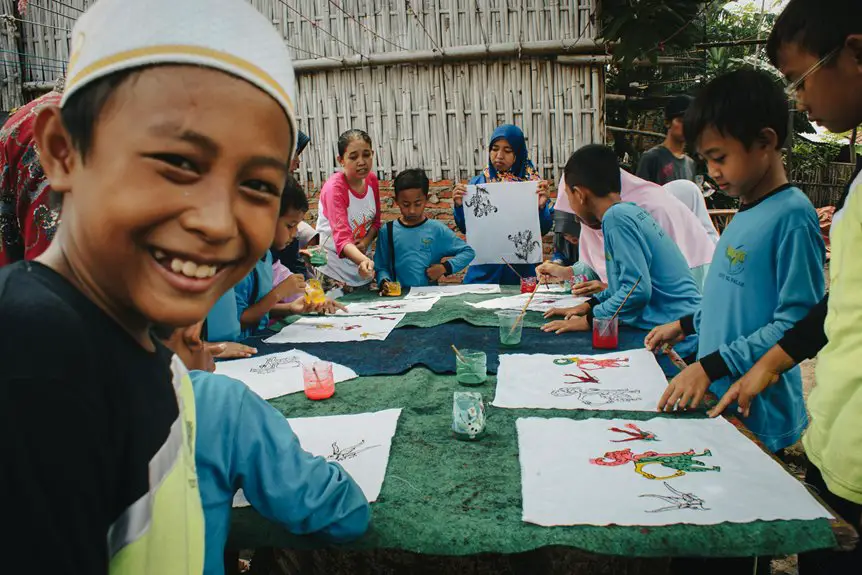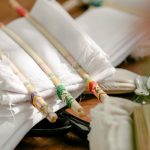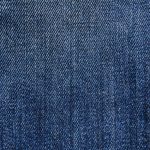You use the batik technique by applying melted wax onto fabric to create patterns that resist dye. First, you outline designs with a canting tool or brush, then submerge the fabric in dye; the waxed areas stay color-free. Repeating wax application and dyeing allows for multi-colored, intricate designs. This traditional method combines art and craft, blending symbolism and creativity. Explore more to uncover batik’s rich history, materials, care tips, and modern twists.
Table of Contents
Key Takeaways
- Batik involves applying melted wax on fabric to resist dye and create intricate patterns.
- Use a canting tool or brush to draw wax designs before dyeing the fabric.
- Dye the fabric in baths, with waxed areas remaining undyed to form patterns.
- Reapply wax and dye multiple times for multi-colored batik designs.
- Remove wax by boiling or scraping after dyeing to reveal the finished artwork.
History and Origins of Batik
Although batik is often associated with Indonesia, its history stretches across several ancient cultures. You’ll find evidence of wax-resist dyeing techniques in places like Egypt, India, and China dating back thousands of years.
These cultures developed unique methods to decorate fabrics using wax to create intricate designs before dyeing. When you explore Indonesian batik, you see how the art evolved into a highly detailed form with symbolic patterns reflecting social status and cultural identity.
You might be surprised to learn that trade routes helped spread batik techniques, blending styles over time. Understanding these origins helps you appreciate batik not just as fabric art but as a rich cultural legacy passed down through generations worldwide.
Materials Needed for Batik Making
To create stunning batik designs, you’ll need a few essential materials that form the foundation of this art. First, select a natural fabric like cotton or silk, as these absorb wax and dye effectively.
Next, gather your wax, traditionally a mixture of beeswax and paraffin, which you’ll melt for application. Finally, prepare your dyes—choose vibrant colors suitable for fabric to bring your designs to life.
Here’s a quick list to get you started:
- Fabric (cotton or silk)
- Wax (beeswax and paraffin blend)
- Fabric dyes (vibrant, colorfast)
With these materials on hand, you’re all set to explore batik’s creative possibilities.
Step-by-Step Process of Applying Wax
Once you’ve melted your wax, you’ll carefully apply it to the fabric to outline and protect areas from dye. Use a canting tool or a brush to draw your design, working steadily to avoid drips.
Start with larger shapes, then add fine details. Remember, the wax acts as a resist, so cover every section you want to remain the original fabric color.
Begin with broad outlines, then refine with details—wax preserves fabric color by acting as a resist.
Work in a well-ventilated area to avoid inhaling fumes, and keep your wax hot to maintain smooth flow. If the wax hardens on your tool, briefly dip it back into the melted wax.
After finishing, let the wax cool and harden on the fabric before moving to the next step. This careful wax application guarantees your design stays crisp throughout the batik process.
Techniques for Dyeing Batik Fabric
After applying the wax and letting it harden, you’re ready to add color to your batik fabric. Dyeing is where your design truly comes to life. Here’s how to approach it:
- Choose Your Dye: Select fabric dyes suitable for cotton or silk, depending on your fabric type. Prepare the dye bath according to instructions.
- Dip and Soak: Submerge your fabric in the dye bath. The waxed areas resist the dye, preserving the original fabric color. Soak until you achieve your desired shade.
- Multiple Colors: For multi-colored designs, apply wax to areas you want to keep in the current color, then repeat dyeing steps with different colors. Each dye layer adds depth and complexity.
Once dyed, let your fabric dry completely before removing the wax.
Different Styles and Patterns in Batik
Although batik techniques share common steps, the styles and patterns you choose can dramatically change your fabric’s character.
You might opt for geometric shapes like diamonds, stripes, or chevrons to give your piece a modern, structured look. Alternatively, organic motifs such as flowers, leaves, or waves can create a soft, natural feel.
Some artists favor intricate, repetitive patterns that demand patience and precision, while others prefer bold, large-scale designs for immediate visual impact. You can also experiment with layering multiple wax applications to build complex, multi-colored patterns.
Cultural Significance of Batik Designs
You’ll find that batik designs carry deep symbolism, with each pattern telling a unique story.
The styles often vary by region, reflecting local traditions and beliefs. Understanding these differences helps you appreciate the cultural richness behind every piece.
Symbolism in Patterns
Patterns in batik carry deep meanings that connect you to the culture and history behind each design.
When you look closely, you’ll see these patterns aren’t just decorative—they tell stories, express beliefs, and symbolize values.
Here’s what you should know about their symbolism:
- Nature motifs like flowers and animals represent life, fertility, and harmony with the environment, reminding you of your connection to the world around you.
- Geometric shapes often symbolize balance, order, and spiritual protection, helping you feel grounded and safe.
- Mythical elements reflect cultural legends and moral lessons, inviting you to explore deeper meanings and traditions passed down through generations.
Regional Design Variations
Regional design variations in batik reveal the rich cultural tapestry behind each piece, reflecting the unique history and traditions of different communities.
When you explore batik from Java, you’ll notice intricate floral motifs symbolizing fertility and prosperity. Meanwhile, in Bali, vibrant colors and bold patterns express spirituality and connection to nature.
If you look at batik from Sumatra, you’ll find geometric shapes representing tribal identity and social status.
These regional differences don’t just add aesthetic value—they communicate stories and beliefs passed down through generations.
Tools Used in Batik Craftsmanship
To create stunning batik designs, you’ll need some essential tools that make wax application precise and manageable.
Instruments like the canting and tjanting help you control the flow of hot wax onto fabric.
Understanding these tools is key to mastering the batik process and bringing your art to life.
Essential Batik Tools
Crafting batik art requires specific tools that help you apply wax and dye with precision. To get started, you’ll need a few essential items that form the backbone of your batik process:
- Fabric – Choose natural fibers like cotton or silk, as they absorb dye well and hold the wax resist effectively.
- Dyes – Select vibrant, colorfast dyes suitable for fabric to guarantee your design remains vivid after multiple washes.
- Containers and brushes – You’ll need heat-resistant containers to melt wax and sturdy brushes to manage your dye application and fabric preparation.
These tools set the stage for your batik work, enabling you to create detailed, colorful patterns.
With the right materials, you’ll enjoy better control over your designs and achieve professional-looking results every time.
Wax Application Instruments
Once you have your fabric, dyes, and basic tools ready, it’s time to focus on the instruments that help you apply wax with accuracy and control. Choosing the right wax application tools can make a huge difference in your batik’s detail and quality. You’ll usually work with a canting for fine lines, brushes for broader strokes, and stamps for repeating patterns. Each tool offers unique control over wax flow and design precision.
| Tool | Description | Best For |
|---|---|---|
| Canting | Small copper spout tool | Fine lines & details |
| Brush | Various sizes & shapes | Large areas & blending |
| Stamp | Carved patterns on wood | Repetitive designs |
| Spoon | Pouring wax smoothly | Covering bigger spots |
Using these instruments thoughtfully will enhance your batik artistry.
How to Care for Batik Textiles
Caring for batik textiles requires gentle handling to preserve their vibrant colors and intricate patterns. You’ll want to avoid harsh treatments that can damage the fabric or fade the dyes.
Follow these steps to keep your batik in great condition:
- Hand wash only: Use cold water and a mild detergent to prevent color bleeding. Avoid wringing or twisting the fabric.
- Air dry: Lay the textile flat or hang it away from direct sunlight to maintain color vibrancy and fabric integrity.
- Iron carefully: Set your iron on low heat and press the batik on the reverse side or use a protective cloth to avoid melting wax remnants or dulling colors.
Modern Innovations in Batik Art
You’ll find that modern batik artists are blending digital tools with traditional wax techniques to push creative boundaries.
You can also explore eco-friendly dyes that make the process more sustainable without sacrificing vibrant colors.
Plus, contemporary design trends are reshaping batik into fresh, eye-catching art forms you’ll want to see.
Digital Tools Integration
Although traditional batik relies on manual wax application and dyeing, digital tools have transformed how artists design and plan their work. You can now use software to create intricate patterns before applying wax, saving time and reducing material waste.
Digital sketching lets you experiment with colors and motifs without committing to fabric right away. Furthermore, digital printing can complement hand-dyeing techniques, allowing you to blend precision with tradition.
Here are three key ways digital tools enhance your batik process:
- Design Visualization – Preview patterns and color combinations on screen.
- Pattern Precision – Achieve intricate details that are hard to draw manually.
- Workflow Efficiency – Speed up planning and reduce trial-and-error with digital mockups.
Eco-friendly Dye Alternatives
As batik artists seek to reduce their environmental impact, eco-friendly dye alternatives have become essential innovations. You can now choose natural dyes derived from plants, fruits, and minerals that offer vibrant colors without harmful chemicals. These sustainable options not only protect the environment but also preserve traditional dyeing techniques. Here’s a quick comparison of popular eco-friendly dyes you might consider:
| Dye Type | Source | Benefits |
|---|---|---|
| Indigo | Indigofera plant | Deep blue, reusable |
| Turmeric | Turmeric root | Bright yellow, antibacterial |
| Henna | Lawsonia inermis | Warm red tones, biodegradable |
| Walnut Hulls | Walnut shells | Rich brown, natural mordant |
Using these dyes helps you create stunning batik art while supporting eco-conscious practices.
Contemporary Design Trends
Embracing eco-friendly dyes opens the door to fresh possibilities in batik art, where tradition meets innovation.
You can now explore contemporary design trends that push the boundaries of this classic technique.
Here are three modern innovations you might want to try:
- Abstract Patterns: Move beyond traditional motifs and experiment with bold, abstract shapes to create striking visual effects.
- Mixed Media: Combine batik with digital printing or embroidery to add texture and depth to your pieces.
- Sustainable Materials: Use organic fabrics and natural waxes to enhance the eco-conscious aspect of your work.
Batik Around the World: Global Influence
When you explore batik beyond its origins, you’ll find that this wax-resist dyeing technique has inspired artists and cultures worldwide. From Indonesia’s rich patterns to Africa’s bold motifs, batik adapts and thrives in diverse settings. You can appreciate how each region adds unique colors, symbols, and stories. This global influence shows batik’s versatility and timeless appeal, inviting you to experiment with your own designs or appreciate international artistry.
| Region | Style Characteristic | Cultural Significance |
|---|---|---|
| Indonesia | Intricate floral motifs | Symbolizes nature & spirituality |
| Africa | Bold geometric shapes | Represents community & identity |
| Malaysia | Symmetrical patterns | Reflects harmony & tradition |
Frequently Asked Questions
Can Batik Techniques Be Applied to Materials Other Than Fabric?
You can definitely use batik techniques on materials beyond fabric, like paper or wood. Just remember, the wax and dye behave differently, so you’ll need to adjust your process to suit each surface.
How Long Does It Take for Batik Wax to Dry Completely?
You wait, you watch, you feel—the wax usually takes about 5 to 10 minutes to dry completely. Depending on thickness and temperature, it might dry faster or slower, so stay patient and keep an eye on it.
Is Batik Fabric Waterproof After Waxing and Dyeing?
You won’t find batik fabric fully waterproof after waxing and dyeing. The wax resists dye, but once removed, the fabric remains porous. It’s water-resistant only until the wax is melted away or worn off.
Can Batik Dyes Be Mixed to Create Custom Colors?
You might think mixing dyes is tricky, but you can definitely blend batik dyes for custom colors. Experimenting with different shades lets you create unique hues, making your artwork truly one-of-a-kind every time you craft.
What Are Common Mistakes Beginners Make in Batik Art?
You often rush applying wax, causing smudges or uneven lines. You might over-soak fabric in dye or use too much wax, blocking colors. Patience and practice help you avoid these common beginner mistakes.
- Is Percale Breathable? Why It’s a Top Choice for Warm Nights - July 14, 2025
- Are Percale Sheets Cool? The Science Behind Their Breathability - July 14, 2025
- What Are Percale Sheets? A Beginner’s Introduction - July 14, 2025






